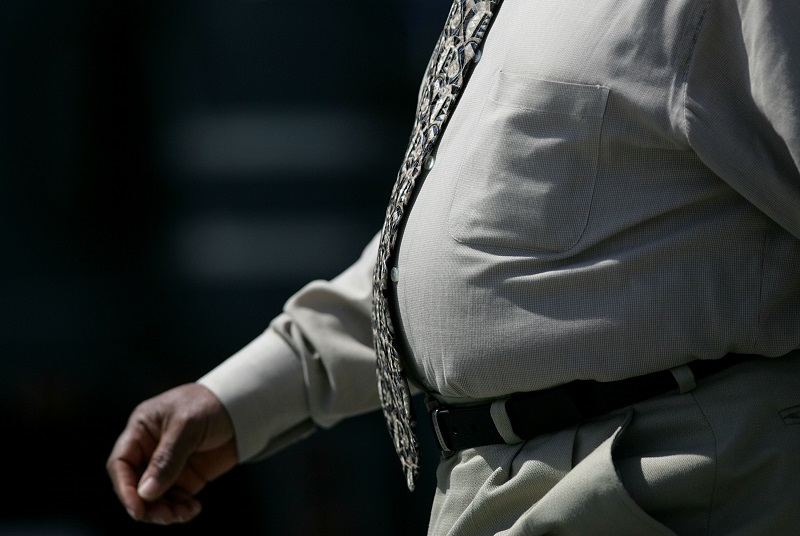Obesity has reached epidemic proportions in America. Nearly 40% of the adult population – roughly 93.3 million people – is seriously overweight, according to the CDC.
Obesity is more common among adults between the ages of 40 and 59 than in younger people or those over the age of 60. Rates are also higher for Hispanics and blacks than they are for whites and Asians.
Obesity rates also vary by occupation. When researchers used data from the National Health Interview survey, they found obesity rates were much higher for people working in some jobs than in others.
The jobs with the highest obesity rates

An overweight man | Justin Sullivan/Getty Images
To get a sense of which jobs had the fattest — and the skinniest — employees, scientists used self-reported weight and height data collected from nearly 126,000 workers between 2004 and 2011 to calculate body mass index, or BMI. The results were published in the Journal of Occupational and Environmental Medicine in 2014.
Obesity rates by occupation were separated by gender and race. However, certain types of jobs tended to rise to the top among all groups.
Motor vehicle operators – a group that includes truck drivers, bus drivers, and taxi drivers – had a high obesity rate across the board. Obesity rates were also high among law enforcement workers and others who worked in protective service jobs, such as security guards. Home health aides, construction workers, and food preparation workers also tended to have high rates of obesity, at least within certain groups. Lower rates of obesity were generally seen among post-secondary teachers, art and design workers, food servers, and doctors and other healthcare practitioners.
Among white, non-Hispanic men, the obesity rate was 27%. The occupations with the highest obesity rates were:
- Motor vehicle operators: 39.2%
- Construction and related workers: 38.6%
- Law enforcement: 38.2%
- Nursing psychiatric and home health aides: 38.1%
Among white, non-Hispanic women, who had an overall obesity rate of 22%, these jobs had the highest obesity rates:
- Agricultural workers: 38.9%
- Drafters, engineering, and mapping technicians: 37.6%
- Food preparation supervisors: 36.6%
- Motor vehicle operators: 36.5%
Black men had an obesity rate of 31.7%. The most obese occupations for this group were:
- Law enforcement: 49.9%
- Motor vehicle operators: 40%
- Other protective services: 38.7%
- Health technologists and technicians: 36.7%
Among black women, the obesity rate was 39.5%, with the highest rates seen in these occupations:
- Motor vehicle operators: 64%
- Food preparation supervisors: 52.2%
- Nursing, psychiatric, and home health aides: 51%
- Other protective services: 50%
Hispanic men had an overall obesity rate of 28.6%, with the highest rates in these jobs:
- Other protective services: 54.3%
- Community and social services: 40.5%
- Construction and extraction supervisors: 42.1%
- Law enforcement: 39.9%
Hispanic women had an obesity rate of 29.1%, with the highest obesity rates in these occupations:
- Motor vehicle operators: 54.2%
- Food preparation supervisors: 39.6%
- Community and social services: 34.8%
- Cooks and food prep workers: 34.2%
The study also found that overall obesity rates increased 4.1% from 2004 to 2011, from 23.5% to 27.6%. Obesity rates for nearly every group increased, with the exception of non-Hispanics of other races.
Staying fit at work

Bananas are a healthy snack. | LightFieldStudios/Getty Images
Though blue-collar jobs topped obesity rankings in this study, those with office jobs aren’t in the clear. The study’s authors found that obesity rates were up significantly among white-collar workers, while rates for blue-collar jobs didn’t change as much “[A] significant portion of the increase in US weight gain can be accounted for by declining workplace physical activity,” they noted.
Employers could help improve workers’ health through workplace health initiatives or introducing standing desks, according to the study authors. Educating workers about the importance of eating fewer sugary drinks and sweets and more healthy food could also help halt the increase in obesity rates.
Check out The Cheat Sheet on Facebook!
Source: Read Full Article
